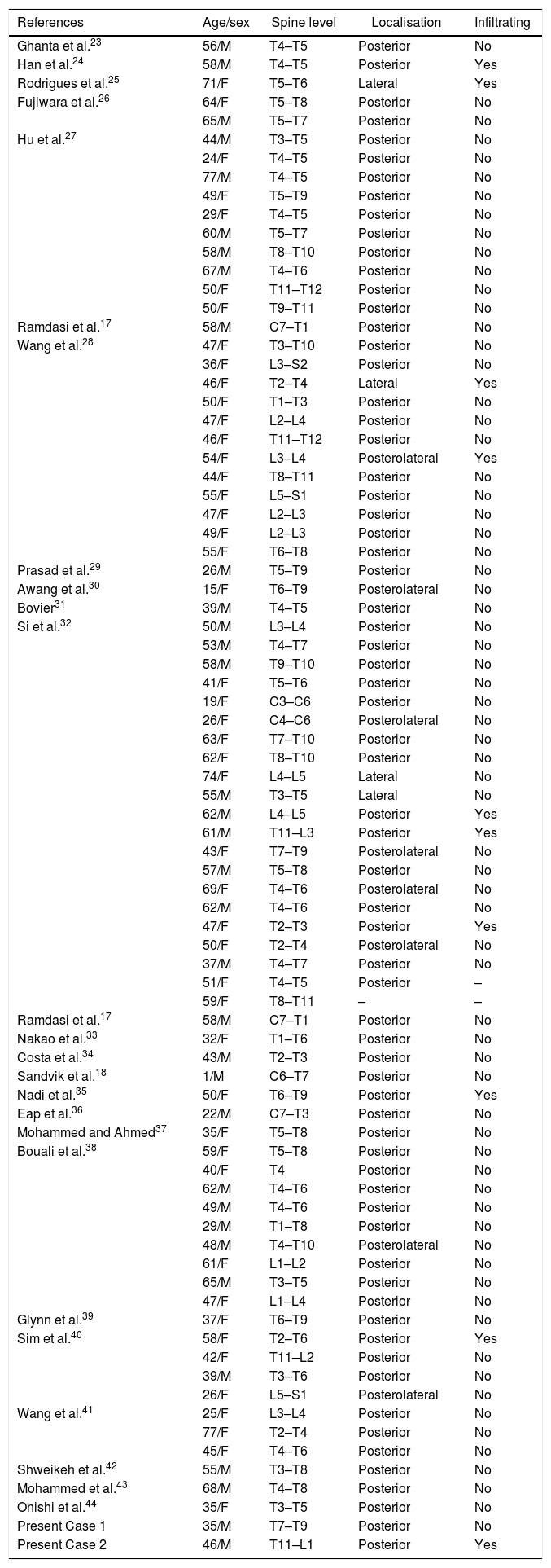Angiolipomas of the spinal canal are a rare condition of unknown origin. They are considered histologically benign; however, some have the potential to infiltrate adjacent structures. The aim of this systematic review was to suggest a potential mechanism for the pathogenesis of spinal angiolipomas, along with a useful approach for their preoperative management.
Materials and methodsA literature review of cases of spinal angiolipoma was performed. In addition, two of the cases encountered in our practice are presented. The first case refers to a 35-year-old male patient with a history of spinal fusion because of a T9 fracture, while the second concerns a 46-year-old male patient with an epidural mass extending outside the spinal canal, who underwent fine needle biopsy and embolisation of its feeding vessel.
ResultsFrom the review of the literature performed, we were unable to identify any correlation between the infiltrative potential and the patients’ demographic and tumour characteristics.
ConclusionsAngiolipomas are considered to be sporadic, yet theories concerning their pathogenesis include reaction to harmful stimuli and congenital malformation of the adipose tissue. Fine needle biopsy may be mistakenly considered non-diagnostic, due to the presence of well-differentiated adipocytes.
Los angiolipomas del canal vertebral son una enfermedad rara de origen desconocido. Se consideran histológicamente benignos, aunque en algunos casos existe la posibilidad de que se infiltren en estructuras adyacentes. El objetivo de esta revisión sistemática es sugerir un posible mecanismo para la patogenia de los angiolipomas espinales, junto con un enfoque útil para su tratamiento preoperatorio.
Materiales y métodosSe realizó una búsqueda bibliográfica de los casos de angiolipomas espinales. Además, se presentan 2 de los casos encontrados en nuestra práctica clínica. El primer caso corresponde a un paciente varón de 35 años con antecedentes de artrodesis vertebral debido a una fractura en T9, mientras que el segundo corresponde a un paciente varón de 46 años con una masa epidural que se extendía fuera del canal vertebral, al que se realizó una biopsia con aguja fina y una embolización del vaso nutricio.
ResultadosA partir de la revisión bibliográfica realizada, no pudimos identificar ninguna correlación entre el potencial de infiltración, los datos demográficos y las características de los tumores de los pacientes.
ConclusionesLos angiolipomas se consideran esporádicos, existiendo, no obstante, teorías referentes a su patogenia que incluyen la reacción a estímulos nocivos y la malformación congénita del tejido adiposo. La biopsia con aguja fina puede considerarse erróneamente como no diagnóstica, debido a la presencia de adipocitos bien diferenciados.
Article

If it is the first time you have accessed you can obtain your credentials by contacting Elsevier Spain in suscripciones@elsevier.com or by calling our Customer Service at902 88 87 40 if you are calling from Spain or at +34 932 418 800 (from 9 to 18h., GMT + 1) if you are calling outside of Spain.
If you already have your login data, please click here .
If you have forgotten your password you can you can recover it by clicking here and selecting the option ¿I have forgotten my password¿.













